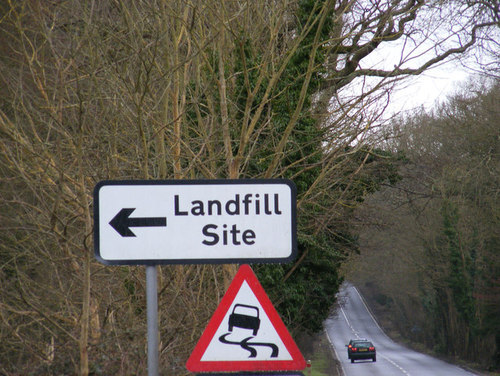
Post: 18 December 2013
Back in October I wrote a blog post questioning the disappearance of key information about landfill sites from the Environment Agency’s “What’s in your backyard?” (WIYBY) online mapping facility.
The basic issue was that a data field classifying individual landfill sites as either “hazardous waste”, “non-hazardous waste” or “inert waste” had been removed without explanation.
I received a swift response from the EA saying that the field had been “inadvertently omitted” and that the website would soon be updated with a new description field.
That has now been done; the new field is identified as “licence type” and for each site contains one of (apparently) nine codes. Brief definitions for the codes are given on the website.
In addition, yesterday the EA responded to an EIR complaint about the missing information, with a copy of some internal e-mail correspondence and a cover letter that attempts to explain why the information was removed.
However the EA’s explanation raises a number of other questions …

It’s not clear from the e-mails and the cover letter that the original data field was actually "inadvertently omitted". The EA indicates there was some “poor communication” and that the original field should not have been removed before the new field was added. However the cover letter says that the decision to remove the original field was agreed in July 2013.
That timeline doesn’t quite square with the evidence. According to an archived copy of the “waste datasearch” page, the functionality required to search the EA website based on landfill class was deactivated sometime prior to 7 September 2012.
According to the definitions, the codes used in the new “licence type” field are mainly derived from the Waste Management Licensing Regulations, which I gather have now been replaced by the Environmental Permitting Regulations. The previous “landfill class” field was derived from the EU Landfill Directive.
The EA has taken the view that the new data field “provides more information to the customer”. This is arguably true in the narrow sense that the new field holds one of nine (or more) possible codes and the previous field held only one of three classes.
However the EA also says: “The data not displayed is still available and we will provide it on request if required.” That seems to be an admission that the new information being provided is not equivalent to the information that has been removed.
The EA’s explanation also ignores the reduction in search functionality. Previously WIYBY users could search for landfill sites based on class, i.e. they could generate a list of hazardous sites. There is no equivalent functionality enabling users to search by particular licence types.
It seems to me that by replacing the three landfill classes with a more complicated list of licence types, and reducing the search functionality, the EA has effectively made it more difficult for the public to identify hazardous landfill sites “in their backyard”.
It’s not precisely clear what process led the EA to conclude that WIYBY users would be better served by obscuring the simple Landfill Directive distinction between hazardous, non-hazardous and inert sites. However I cannot help but wonder which presentation of the information the waste management industry would prefer.
Of course the wider problem is the WIYBY model itself. View-only web mapping facilities are no longer the gold standard for public communication of environmental data.
Increasingly, the norm for full transparency is an open data release. Users expect to be able to download and analyse complete datasets rather than simply read snippets of information presented within design constraints imposed by a public authority.
Most questions around how the EA is communicating or should be communicating information about landfill sites could be obviated by releasing the underlying datasets as open data.
Landfill Site sign photograph by Adrian Cable (CC BY-SA 2.0)
Update: 12 January 2013
Ian Carroll of Sandwell Swanwatch, who raised the original EIR request and complaint that drew my attention to all of the above issues, has published a blog post about his correspondence with the EA: